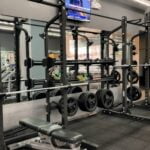Tennis is a physically demanding sport that requires a combination of strength, agility, endurance, and power. To perform at their best and prevent injuries on the court, tennis players need to prioritize fitness exercises that specifically target the demands of the game.
In this article, we will explore the best fitness exercises for tennis players, covering warm-up exercises, essential cardio workouts, strength training exercises, agility drills, core exercises, flexibility routines, recovery exercises and stretches, as well as cross-training activities.
Before stepping foot on the court, it is crucial for tennis players to properly warm up their bodies to prevent injuries. Warm-up exercises help increase blood flow to the muscles and prepare them for the intense physical activity ahead. These exercises typically include dynamic stretches that involve moving through a full range of motion, such as arm circles and leg swings. Additionally, light cardiovascular activities like jogging or jump rope can also be incorporated into the warm-up routine.
Cardiovascular endurance is essential in tennis to sustain long rallies and maintain consistent performance throughout a match. Therefore, incorporating cardio workouts into your training regimen is crucial. Activities such as running or cycling are excellent choices because they mimic the continuous movement required during matches. High-intensity interval training (HIIT) is also an effective option as it helps improve both aerobic and anaerobic capacity.
Stay tuned for the rest of this article as we delve deeper into each category of fitness exercises specifically tailored to enhance a tennis player’s performance on the court. Whether you’re a beginner looking to improve your skills or an advanced player seeking ways to take your game to the next level, these exercises will help you become stronger, faster, and more agile on and off the tennis court.
Essential cardio workouts to improve endurance on the tennis court
Cardiovascular endurance is crucial for tennis players as they need to sustain their high-intensity gameplay throughout matches that can last for hours. Without proper endurance, players may experience fatigue, decreased performance, and an increased risk of injuries. Incorporating essential cardio workouts into their training routine can significantly improve their endurance on the tennis court.
Interval Training
One of the most effective cardio workouts for tennis players is interval training. This type of workout involves alternating between high-intensity bursts of exercise and short periods of rest or lower intensity activity. Interval training helps mimic the intensity and duration of a tennis match, making it an excellent choice for improving cardiovascular fitness.
During interval training sessions, tennis players can engage in activities such as sprinting, cycling, or jumping rope at maximum effort for a short period, followed by a brief recovery period. For example, players can sprint for 30 seconds and then walk or jog slowly for 60 seconds before repeating the cycle. This type of workout improves aerobic capacity by pushing the heart rate up quickly and allowing it to recover during rest intervals.
Long-Distance Running
Long-distance running is another valuable cardio exercise for tennis players looking to enhance their endurance levels. Regular long-distance runs help build stamina over time by strengthening the heart muscles and improving lung efficiency. It is recommended to gradually increase distance and pace to prevent overexertion and injury.
Tennis players can choose running routes that simulate the conditions experienced on a tennis court – such as uneven terrain or inclines – to make the workout more specific to their sport. Additionally, cross-training with other forms of cardiovascular exercise like swimming or cycling can offer variety while still providing endurance benefits.
Circuit Training
Circuit training combines both cardiovascular exercises and strength-based movements into one intense workout session. By performing a series of exercises with minimal rest in between, circuit training targets multiple aspects of fitness simultaneously, including cardiovascular endurance. This type of workout can be customized to include exercises specific to tennis, such as high knees, side shuffles, or ladder drills.
Incorporating circuit training into a tennis player’s training regimen helps mimic the stop-and-start nature of the sport while improving aerobic capacity and muscular strength. For example, players can move through a circuit that includes jumping jacks, push-ups, squat jumps, burpees, and mountain climbers. By continuously challenging the cardiovascular system under different physical demands, players can enhance their overall endurance on the tennis court.
By including these essential cardio workouts in their training routines, tennis players can improve their endurance levels and stay match-fit for longer durations. It is essential to consult with a coach or fitness professional to tailor these workouts according to individual needs and gradually increase intensity over time for optimal performance gains.
Strength training exercises to enhance power and explosiveness in tennis shots
Strength training exercises are essential for tennis players looking to enhance their power and explosiveness on the court. These exercises focus on developing the muscles used in tennis shots, such as the upper body, lower body, and core muscles. By incorporating strength training into your fitness routine, you can improve your shot velocity and generate more power in your strokes.
One effective strength training exercise for tennis players is the medicine ball throw. Stand with your feet shoulder-width apart and hold a medicine ball in both hands. Start by squatting down while holding the medicine ball at chest level. As you stand up, explosively throw the ball forward as far as possible. This exercise mimics the movement of a forehand or backhand shot and helps develop power in your torso and arms.
Another great exercise for enhancing power in tennis shots is plyometric push-ups. Start in a push-up position with your hands slightly wider than shoulder-width apart. Lower yourself down into a push-up position, then explode upward so that your hands leave the ground. Land softly back into the starting position and repeat for multiple reps. Plyometric push-ups work your upper body muscles and increase explosive power in your shots.
In addition to these exercises, it’s important to include strength training exercises that target specific muscle groups used in tennis, such as lunges for leg strength and rows for upper back muscles. Remember to consult with a fitness professional or coach to ensure proper form and technique when performing these exercises.
| Exercise | Muscles Targeted |
|---|---|
| Medicine Ball Throw | Torso and Arms |
| Plyometric Push-Ups | Upper Body Muscles |
| Lunges | Leg Strength |
| Rows | Upper Back Muscles |
Agility drills to improve quick movement and reaction time during matches
Agility drills are a crucial component of any tennis player’s training routine. These exercises focus on improving quick movement and reaction time, helping players to navigate the court with ease and respond swiftly to their opponent’s shots. By incorporating agility drills into their fitness regimen, tennis players can enhance their overall performance on the court.
One popular agility drill for tennis players is the ladder drill. This exercise involves using an agility ladder to perform a variety of footwork patterns, such as high knees, lateral shuffles, and diagonal runs. The ladder drill helps improve foot speed, coordination, and agility, which are essential for quickly changing direction during matches.
Another effective agility drill is the cone drill. This exercise requires placing cones in a specific pattern on the court or training area. Players then move quickly between the cones in various patterns, such as figure eights or zig-zags. The cone drill improves lateral movement, acceleration, and deceleration abilities, all of which are crucial for moving quickly around the court.
In addition to ladder and cone drills, other agility exercises that tennis players can incorporate into their training include lateral hops over hurdles, side lunges with a medicine ball twist, and box jumps. These exercises work to improve explosive power, balance, and stability – all important elements of quick movement on the tennis court.
| Agility Drill | Description | Benefits |
|---|---|---|
| Ladder Drill | Performing various footwork patterns using an agility ladder. | Improves foot speed, coordination, and agility. |
| Cone Drill | Moving quickly between cones in specific patterns. | Enhances lateral movement and acceleration abilities. |
| Lateral Hops over Hurdles | Hopping sideways over hurdles placed in a line. | Improves explosive power, balance, and stability. |
| Side Lunges with Medicine Ball Twist | Sideways lunges while twisting a medicine ball from side to side. | Enhances lateral movement and rotational strength. |
| Box Jumps | Jumping onto a box or platform from a standing position. | Improves explosive leg strength and vertical jump ability. |
Core exercises for a stable and balanced body on the tennis court
Importance of Core Strength in Tennis
Having a strong and stable core is essential for tennis players as it provides the foundation for all their movements on the court. The core muscles, including the abdominals, obliques, lower back, and hips, help maintain balance, transfer power between the upper and lower body, and generate force for powerful shots. By incorporating targeted core exercises into their training routine, players can improve their stability, prevent injuries, and enhance their overall performance on the tennis court.
Plank Variations
One of the most effective exercises to strengthen the core is planking. There are various plank variations that target different areas of the core muscles. The standard plank is performed by supporting your body weight on your forearms and toes while maintaining a straight line from head to toe.
Hold this position for 30 seconds to begin with and gradually increase the duration over time. Side planks are another variation where you support your body weight on one forearm and rotate into a side plank position. This exercise strengthens the obliques which are important for rotational movements in tennis strokes.
Medicine Ball Twists
Another effective exercise to develop rotational strength is medicine ball twists. Sit down with your knees bent and hold a medicine ball against your chest. Lean back slightly while keeping your back straight. Begin twisting from side to side using your torso muscles while holding onto the medicine ball. This exercise simulates rotational movements during tennis strokes like forehands and backhands.
By incorporating these core exercises into their training routine, tennis players can improve their stability on the court, generate more power in their shots, and reduce the risk of injuries. It is important to note that proper form and technique should be maintained during these exercises to maximize benefits while minimizing any risk of injury. Consulting with a fitness professional or coach can also help design a personalized core workout program tailored to a player’s specific needs and goals.
Flexibility routines to prevent muscle strains and improve range of motion
Flexibility is a crucial aspect of tennis training that should not be overlooked. By incorporating flexibility routines into your workout regimen, you can prevent muscle strains, improve range of motion, and ultimately enhance your overall performance on the tennis court.
One effective way to improve flexibility is through dynamic stretching exercises. These exercises involve moving parts of your body through a full range of motion in a controlled manner. Dynamic stretching helps to increase blood flow to your muscles and prepare them for the demands of tennis. Some examples of dynamic stretches that are beneficial for tennis players include:
- Arm circles: Stand with your feet hip-width apart and extend your arms out to the sides. Rotate your arms in large circles forward for 10-15 repetitions, then switch to rotating them backward.
- Leg swings: Stand next to a wall or hold onto something stable for balance. Swing one leg forward and backward in a controlled manner, gradually increasing the height of the swing as you feel more comfortable. Repeat for 10-15 swings on each leg.
- Trunk twists: Stand with your feet shoulder-width apart and place your hands on your hips. Rotate your upper body from side to side, keeping your lower body stable. Perform 10-15 twists on each side.
In addition to dynamic stretching, static stretching exercises can also be incorporated into your flexibility routine. Static stretches involve holding a stretch position for a prolonged period of time, typically around 20-30 seconds. This type of stretching helps to elongate muscles and improve their flexibility over time.
Some beneficial static stretches for tennis players include:
- Hamstring stretch: Sit on the ground with one leg extended in front of you and the other leg bent with the sole of your foot against the inner thigh of the extended leg. Keeping your back straight, reach forward towards your toes until you feel a gentle stretch in the back of your thigh. Hold for 20-30 seconds on each leg.
- Shoulder stretch: Stand with your feet shoulder-width apart and reach one arm across your chest, holding it in place with the opposite arm. Feel the stretch in your shoulder and hold for 20-30 seconds on each side.
- Hip flexor stretch: Kneel on one knee with the other foot planted flat on the ground in front of you. Keeping your upper body straight, lean forward slightly to feel a stretch in the front of your hip. Hold for 20-30 seconds on each side.
By incorporating both dynamic and static stretching exercises into your workout routine, you can maintain flexibility, prevent muscle strains, and improve your range of motion. Flexibility is an essential component of tennis performance, as it allows for fluid movements and helps to increase power and efficiency in shots. Incorporate these flexibility routines into your training sessions to achieve peak performance on the tennis court.
Recovery exercises and stretches to minimize soreness and promote faster healing
After an intense tennis match or practice session, it is important to prioritize recovery in order to minimize soreness and promote faster healing. Recovery exercises and stretches can help alleviate muscle tension, improve flexibility, and restore the body’s natural balance. Incorporating these activities into your post-tennis routine will not only enhance your overall fitness, but also decrease the risk of injury.
To minimize soreness and promote faster healing, try incorporating the following recovery exercises and stretches into your routine:
Foam Rolling
Using a foam roller can help release muscle tension and knots by applying pressure to specific areas of the body. Roll over different muscle groups such as the calves, hamstrings, quadriceps, and IT band for about 1-2 minutes per area.
Static Stretching
Engaging in static stretching after playing tennis can help lengthen the muscles that may have tightened during physical activity. Focus on stretching major muscle groups including the shoulders, chest, back, hips, and legs. Hold each stretch for 15-30 seconds without bouncing.
Yoga or Pilates
Incorporating yoga or Pilates into your recovery routine can improve flexibility, strengthen core muscles, and promote relaxation. These activities also enhance body awareness and alignment which are crucial for efficient movement on the tennis court.
Cool Down Walk or Light Jog
After playing tennis, take a few minutes to cool down with a brisk walk or light jog. This helps gradually lower your heart rate and allows lactic acid to dissipate from your muscles.
Remember to listen to your body and adjust intensity or duration as needed when performing these recovery exercises and stretches. By prioritizing recovery after playing tennis, you will not only experience reduced soreness but also reap the benefits of improved performance during future matches or practice sessions.
Cross-training activities to enhance overall fitness and complement tennis performance
Cross-training activities are a valuable addition to any tennis player‘s fitness routine as they enhance overall fitness and complement performance on the court. Engaging in cross-training exercises not only provides variety to the training regimen, but also targets different muscle groups and helps prevent overuse injuries. By incorporating activities such as swimming, cycling, or weightlifting into their training, tennis players can improve their cardiovascular endurance, strength, and flexibility.
One popular cross-training activity for tennis players is swimming. Swimming is a low-impact exercise that offers a full-body workout while minimizing stress on the joints. It improves cardiovascular endurance and lung capacity, which are crucial for maintaining stamina during long matches. Additionally, swimming engages the upper body muscles used in tennis strokes such as the shoulders, back, and arms, helping to strengthen these muscle groups.
Cycling is another effective cross-training exercise for tennis players. Riding a bike not only improves cardiovascular fitness but also builds lower body strength and endurance. Cycling targets the leg muscles used in quick movements on the tennis court, such as lunges and lateral shuffles. In addition, cycling helps develop stability in the hips and core muscles which is essential for maintaining balance during aggressive shots or quick changes of direction.
Weightlifting is another beneficial cross-training activity that can enhance overall fitness for tennis players. Incorporating resistance training into their routine can help players develop power and explosiveness in their shots by strengthening the muscles involved in generating force such as the legs and upper body. Additionally, weightlifting aids in building bone density and promoting joint stability which reduces the risk of injury on the court.
In conclusion, engaging in cross-training activities is an excellent way for tennis players to enhance their overall fitness level while complementing their performance on the court. By incorporating activities like swimming, cycling, or weightlifting into their training routine, players can improve their cardiovascular endurance, strength, flexibility, and reduce the risk of overuse injuries.
These activities target different muscle groups, providing variety and helping players achieve a well-rounded fitness foundation that will benefit them in their tennis games.

Passionate about providing useful information to anyone with an interest in the field of Personal Training, I strive to pass on to our readers quality information and to answer any questions about Personal Trainers, the work they do and how to become one.





